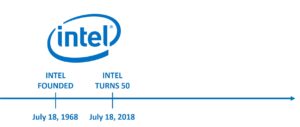One of my favorite memories of Intel is a bumper sticker that read, “My Dad is a ‘successful/equal’ at Intel”—a joking April Fool’s Day reference to the most typical rating given at that time in the company’s yearly performance reviews.

That common rating said, in essence, that you were successfully doing what was expected of you and were learning and developing at a rate equal to your peers.
In a culture fueled by high expectations—and an understanding that your job was to exceed them—the message that you were “meeting expectations” was a buzz-kill experienced by most of us each year in Intel’s “Focal” assessment process. But it was far better than the dark shadow and stringent get-well plan that would come with a “does not meet” assessment.
As Intel turns 50 this week, I’ve been thinking a lot about those high expectations—but less about the pressure cooker they created and more about the magic they inspired.
When your company’s dominant mantra is Moore’s Law—an exhortation to double the performance of your chips every couple of years—it’s not surprising that the exponential curve of transistor density would become a metaphor for human expectations as well.
It’s no fun, of course, to be continually asked to do 10X better and 10X faster with 10X more creativity. (Or 100X.) But it sure does lead to things you might not have discovered without that push: questions, insights, solutions, creations.
(I try to remember this observation when a client—or my spouse—asks why we can’t achieve a very difficult “X.” Such questions are invitations to discovery—why not welcome them?)
The most magical leaders at Intel were those who would invite their teams to achieve the impossible, rather than presumptuously demanding it. But let’s face it: even a gruff demanding manager (and Intel has had its share) is still offering invitations to excellence, to greatness, if you can hear and translate the invitation.
I liked to think that Robert Noyce and Gordon Moore (and their first hire, Andy Grove), when they founded Intel, were more interested in the kind of company they would build than in what exactly the company would make. The egalitarian nature of the company that emerged, and its resulting influence on Silicon Valley, is now legendary but that doesn’t make it less true. At Intel, the culture of cubes-for-everyone, first-name-execs, ask-any-question-anytime, constructive confrontation, and “see a problem, fix a problem” wasn’t just for show. It was real and informed everything, especially problem solving, where the mantra was “attack the problem, not the person.”
Those cultural directives were lived imperfectly at times—these were humans, after all—but more often they were driven with integrity, discipline and care, and thus remarkable to experience.
In my time at Intel I never met Noyce (he died 5 years before I joined), but I got to spend a little time with Moore and was lucky to work many hours one-on-one with Grove. I once asked Grove if, in the early years, he had a sense of the iconic company Intel would become years ahead. He laughed. “We didn’t have time to think like that; we were too busy doing things like mopping up water leaks on the factory floor.”
Grove himself wasn’t always the Grove he would become. The tough operations manager would grow into the still-tough but broad-thinking management innovator and business strategist. He was always proud of Intel but never misty-eyed about its place in the world. (He wouldn’t inflate his own importance, either; his official description was not “founder” of Intel but the more precise “participant in the founding of Intel.”)
Intel turns 50 amid some ironies:
- A company known for classic leadership celebrates this birthday without a CEO, since the tarnished resignation of Brian Krzanich. Intel is blessed, though, with a gift of a chairman in Andy Bryant, whose own strategic strength and decades-long dedication to Intel are themselves legendary.
- The rumored candidacy of Diane Bryant to succeed Krzanich would be an elegant return for a respected woman leader who left Intel a year ago and would continue (more or less) the tradition of appointing CEOs who grew up inside Intel.
- Intel has an established a major leadership position and built a high-growth business in data centers and the cloud—partly thanks to Diane Bryant—decades after it first entered the server marketplace with enhanced PC processors that the competition mocked as Cracker Jack toys.
- The company that began in memory chips, led there and lost there, and famously shifted to microprocessors is now enjoying a resurgence in memory leadership with dramatic advances in non-volatile memory technology—which not only thrives in its own markets but enhances many of Intel’s other business areas.
That shift decades ago from memories to microprocessors is one of my favorite Intel stories, for two reasons. One, it was much harder and slower to re-focus the company (and even top execs) than the histories suggest. Two, it’s a classic story of personal responsibility, with Grove and Moore asking themselves: “If we were fired, what would our successors do?” And answering: “Get out of memories and focus on microprocessors.” And concluding: “So why don’t we do that ourselves?”
See a problem, fix a problem. In a company where expectations are extreme and all humans are equal, the expectations are extreme for everyone. Even its executives.
Grove was perhaps the most famous of all Intel’s CEOs, earning Man of the Year honors from Time magazine and leading Intel into the Internet age. If Grove were asked about the next 50 years? I suspect he’d say, “Nobody can pretend to see that far out. But it will be what we make it.”

